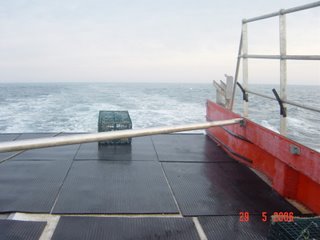As soon as the fishermen see the lobster trap appearing out of the water (it's being pulled up by the rope) they haul it up and quickly start to sort it out. First they take out the lobsters caught and put them in a basket. Then they put new bait in the lobster trap. They used Herring fish with the odd Mackeral for bait. Then they put the trap down on the boat ready to go back in the water and they quickly move on to the next trap tied to the rope. When they finish doing this for all the traps, they let the rope go back in the water and it pulls the now empty traps with new bait back in the water one by one.
 Chad and Jeremy haul up a lobster trap
Chad and Jeremy haul up a lobster trap Chad and Jeremy open the trap to see what lobster they've caught
Chad and Jeremy open the trap to see what lobster they've caught
 One bag of new bait ready to go in an empty lobster trap
One bag of new bait ready to go in an empty lobster trap
 Lobsters caught from the first bunch of traps
Lobsters caught from the first bunch of trapsIn the meantime, the captian of the boat Daniel, moves the boat to the next location where a bunch of lobster traps are. As the boat is moving, Chad and Jeremy measure the lobsters caught one by one. It is illegal here to catch lobster that is smaller than a certain measure. These small lobsters are called 'tinkers' and have to be thrown back into the water to ensure conservation of future lobster in the sea. Jeremy measures the lobster to see if they're large enough to keep. Out of every catch that day, about 98% of the lobster caught were infact 'tinkers' and had to be thrown back in the water.
 Daniel moving the boat to the next location of lobster traps
Daniel moving the boat to the next location of lobster traps Gary measuring a lobster under Jeremy's supervision
Gary measuring a lobster under Jeremy's supervision
When eventually, there was one large enough to keep, we had to put these special bands round their claws to identify them as Nova Scotian Lobster. Gary really enjoyed learning how to measure the lobster and band them. I had a go at banding a lobster too.
I am having problems uploading any more photos on this post so will continue in my next post.
TO BE CONTINUED...
No comments:
Post a Comment